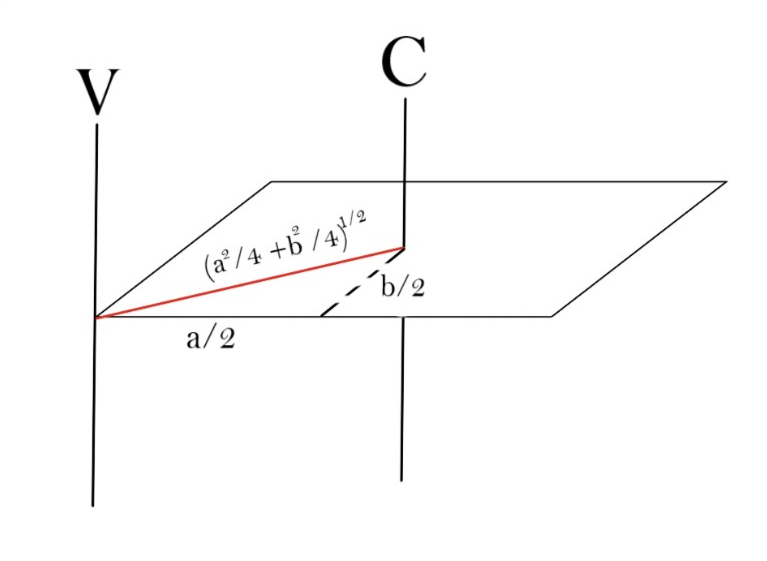
The moment of inertia of thin uniform rectangular plate relative to the axis passing perpendicular to the plane of the plate through one of its vertices, if the sides of the plate are equal to $a$ and $b$ , and mass $m$ is $I = \dfrac{m}{x}\left( {{a^2} + {b^2}} \right)$. Find the value of $x$.
Answer
585.3k+ views
Hint: We will use Parallel axis theorem to find the moment of inertia of the plate with respect to axis which is perpendicular and passing through the vertices of the plate as we know the moment of inertia of the plate with respect to axis which is perpendicular to the plane and passing through the center of the plate.
Complete step by step answer:
Let the moment M.I of the plate about an axis which is perpendicular to the plane and passing through the center is ${I_c}$ and the M.I of the plate about an axis which is perpendicular to the plane and passing through one of the vertices of the rectangular plate is ${I_v}$.
Respective axes are shown in the figure below

According to parallel Axis Theorem,
${I_v} = {I_c} + m{l^2}$
Where,
$l = $perpendicular distance between the parallel axes.
$l = \sqrt {{{\left( {\dfrac{a}{2}} \right)}^2} + {{\left( {\dfrac{b}{2}} \right)}^2}} $
${I_c} = \dfrac{m}{{12}}\left( {{a^2} + {b^2}} \right)$
So,
${I_v} = \dfrac{m}{{12}}\left( {{a^2} + {b^2}} \right) + m\left( {\dfrac{{{a^2}}}{4} + \dfrac{{{b^2}}}{4}} \right)$
${I_v} = m\left( {{a^2} + {b^2}} \right)\left[ {\dfrac{1}{{12}} + \dfrac{1}{4}} \right]$
${I_v} = \dfrac{m}{3}\left( {{a^2} + {b^2}} \right)$
On comparing,
$x = 3$
Additional information:
> Moment of inertia plays the role in rotational mechanics is same as mass plays in linear kinetics. They both are characterized as the resistance of the body to change in its state of rest or state of motion.
> Moment of inertia depends upon the distribution of mass in space and the axis of rotation. For a point-like mass the moment of inertia is directly given as $m{r^2}$but it will change as we change the distribution of mass around the axis of rotation.
Note: Parallel axis theorem is also valid in case of 3D objects like cone, hemisphere. Perpendicular axis theorem is always valid for 2D shapes only.
Complete step by step answer:
Let the moment M.I of the plate about an axis which is perpendicular to the plane and passing through the center is ${I_c}$ and the M.I of the plate about an axis which is perpendicular to the plane and passing through one of the vertices of the rectangular plate is ${I_v}$.
Respective axes are shown in the figure below

According to parallel Axis Theorem,
${I_v} = {I_c} + m{l^2}$
Where,
$l = $perpendicular distance between the parallel axes.
$l = \sqrt {{{\left( {\dfrac{a}{2}} \right)}^2} + {{\left( {\dfrac{b}{2}} \right)}^2}} $
${I_c} = \dfrac{m}{{12}}\left( {{a^2} + {b^2}} \right)$
So,
${I_v} = \dfrac{m}{{12}}\left( {{a^2} + {b^2}} \right) + m\left( {\dfrac{{{a^2}}}{4} + \dfrac{{{b^2}}}{4}} \right)$
${I_v} = m\left( {{a^2} + {b^2}} \right)\left[ {\dfrac{1}{{12}} + \dfrac{1}{4}} \right]$
${I_v} = \dfrac{m}{3}\left( {{a^2} + {b^2}} \right)$
On comparing,
$x = 3$
Additional information:
> Moment of inertia plays the role in rotational mechanics is same as mass plays in linear kinetics. They both are characterized as the resistance of the body to change in its state of rest or state of motion.
> Moment of inertia depends upon the distribution of mass in space and the axis of rotation. For a point-like mass the moment of inertia is directly given as $m{r^2}$but it will change as we change the distribution of mass around the axis of rotation.
Note: Parallel axis theorem is also valid in case of 3D objects like cone, hemisphere. Perpendicular axis theorem is always valid for 2D shapes only.
Recently Updated Pages
Master Class 11 Economics: Engaging Questions & Answers for Success

Master Class 11 English: Engaging Questions & Answers for Success

Master Class 11 Social Science: Engaging Questions & Answers for Success

Master Class 11 Biology: Engaging Questions & Answers for Success

Class 11 Question and Answer - Your Ultimate Solutions Guide

Master Class 11 Business Studies: Engaging Questions & Answers for Success

Trending doubts
What is meant by exothermic and endothermic reactions class 11 chemistry CBSE

10 examples of friction in our daily life

One Metric ton is equal to kg A 10000 B 1000 C 100 class 11 physics CBSE

Difference Between Prokaryotic Cells and Eukaryotic Cells

What are Quantum numbers Explain the quantum number class 11 chemistry CBSE

1 Quintal is equal to a 110 kg b 10 kg c 100kg d 1000 class 11 physics CBSE




